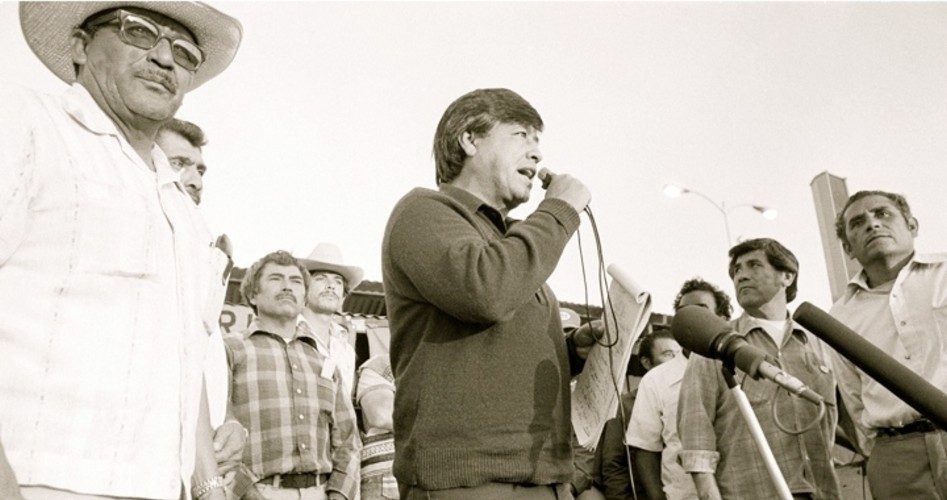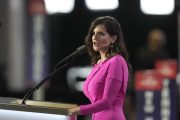
The White House issued a press release on October 1 stating that President Obama will travel to Keene, California, on October 8 “to announce the establishment of the César E. Chávez National Monument.” The release notes that the monument in honor of the highly controversial labor leader will be established on the property known as Nuestra Señora Reina de la Paz (“Our Lady Queen of Peace,” in Spanish), commonly shortened to “La Paz.”
Chávez lived with his family on the property, which served as the national headquarters of the United Farm Workers (UFW) labor movement, from the 1970s until his death in 1993. He is buried at the National Chávez Center at the UFW’s headquarters campus on the Keene property.
“César Chávez gave a voice to poor and disenfranchised workers everywhere,” the press release quoted President Obama. “La Paz was at the center of some of the most significant civil rights moments in our nation’s history, and by designating it a national monument, Chávez’ legacy will be preserved and shared to inspire generations to come.”
The statement notes that the monument will include “a Visitors’ Center containing César Chávez’s office as well as the UFW legal aid offices, the home of César and Helen Chávez, the Chávez Memorial Garden containing Chavez’s grave site, and additional buildings and structures at the La Paz campus.”
An AP report about the establishment of the monument implied a possible political motivation for the timing of the announcement, noting it is: “a move likely to shore up support from Hispanic and progressive voters just five weeks before the election.”
The report recalled Chávez’s role, as head of the UFW, in staging a massive grape boycott to draw attention to his labor activism.
A Wikipedia biography of Chávez notes that following the onset of the Delano grape strike by Filipino American farmworkers in September 1965, Chávez and his National Farm Workers Association (NFWA) — later called United Farm Workers (UFW) — lent his support. Six months later, notes the article, “Chávez and his and the NFWA led a strike of California grape pickers on the historic farmworkers march from Delano to the California state capitol in Sacramento for similar goals. The UFW encouraged all Americans to boycott table grapes as a show of support. The strike lasted five years and attracted national attention.”
A Los Angeles Times article about the event quoted Paul F. Chávez, president of the Cesar Chávez Foundation and the middle son of the labor organizer. “So we are happy,” Chávez said, “that the story of La Paz, which was a spiritual harbor and a place where my dad and thousands of selfless people worked for social justice over the years, will forever be shared with the nation through the National Park Service.”
The article referred to Chávez as both a “civil rights and labor leader.” [Emphasis added.]
For the casual observer, the story of Cesar Chávez is an interesting, perhaps even romantic, saga of a courageous civil rights leader walking among oppressed agricultural workers, organizing them, and leading them to a better life. As usual, however, there is “the rest of the story,” and one of the best exposés of Chávez and the UFW was published in American Opinion magazine (a predecessor to The New American) back in June 1966. Written by the late Gary Allen, the title of the article was “The Grapes: Communist Wrath in Delano.”
One of the first points that Allen made was that the so-called Delano grape strike was not a strike at all. As Allen observed:
How can a strike not be a strike? Very simple: When the workers are still at work, but are being picketed by outsiders who never worked there. This year’s grape crop, you see, is up nine percent over last year’s and it has now been harvested and marketed by the men who have always done the job. Contrary to what the mass media have been telling the public, the workers have not been on strike in Delano; the workers are, in fact, being struck by outside revolutionaries. True, two “unions,” the A.F.L. C.I.O.’s Agricultural Workers’ Organizing Committee (A.W.O.C.), and the upstart National Farm Workers’ Association (N. F. W. A. ), are trying to unionize the agricultural workers in the Delano area. A.W.O.C. even called a “strike,” and was later joined by N.F.W.A. — but the “strike” leaders were generals without armies. Workers wanted to work, not strike. So it was that the organizing revolutionaries assembled a crew of outsiders, set up picket lines, and declared that the people out in the fields picking grapes, the same ones who for the most part have been picking grapes there for years, are strike-breakers and scabs. Of course, it is not true, but how will the people in the cities know?
The key to the mystery, Allen explained, was the background of Cesar Chávez himself. Chávez was recruited and hired in the early 1950s by a staff member for Saul Alinsky’s Industrial Areas Foundation. Allen observed that “Chávez could have found no better training ground for revolution. His mentor Alinsky describes himself as a ‘professional radical’ and is author of Reveille For Radicals and Rules for Revolution (to be published this year [1966]). He runs a prep school in grass-roots organizing for revolution based upon picketlines, boycotts, mass meetings, rent strikes, demonstrations, and sit-ins.”
Allen noted that Chávez “spent six years in Chicago studying at the “Alinsky School of Revolution” before his “teachers” thought he was ready to return to California to found the N.F.W.A.”
The name Saul Alinsky should have more than passing familiarity among those who have studied the history of radical political organizing in America. As a refresher, The New American has published several detailed analyses of the man, including “Saul Alinsky: A Radical Who Matters,” by Gregory A. Hession, on October 28, 2008. In tracing Alinsky’s legacy of radical community organizing, Hession noted:
After Alinsky’s death in 1972, many large new community-organizing networks developed using his methods. These include Alinsky’s own Industrial Areas Foundation (IAF), along with ACORN, Citizen Action, National People’s Action, PICO, DART, and the Gamaliel Foundation. IAF and its progeny have produced radical organizing luminaries such as Cesar Chávez. Many of these groups have been instrumental in promoting Barack Obama’s presidential candidacy.
Another writer who devoted considerable time and space to exposing Alinsky is Dr. Sam Blumenfeld. Blumenfeld also projected the lines to demonstrate the effect of Alinsky’s methodology and philosophy on the Obama administration. In “The Alinsky Effect or How to Understand Barack Obama,” Blumenfeld observes:
If you want to be able to understand Obama, our Community Organizer-in-Chief, you have to read Saul Alinsky’s two books, Rules for Radicals and Reveille for Radicals, which Obama read and obviously absorbed. Otherwise, you won’t have a clue as to what he means by his words and actions. Those two books contain the basics of Alinsky’s ideas of revolutionary radicalism which Obama spent several years learning.
Blumenfeld’s point was reinforced by a statement made by none other than Saul Alinsky’ son, L. David Alinsky. Blumenfeld quoted a statement made by the younger Alinsky in a letter to the Boston Globe, published on August 31, 2008:
Barack Obama’s training in Chicago by the great community organizers is showing its effectiveness. It is an amazingly powerful format, and the method of my late father always works to get the message out and get the supporters on board. When executed meticulously and thoughtfully, it is a powerful strategy for initiating change and making it really happen. Obama learned his lesson well.
I am proud to see that my father’s model for organizing is being applied successfully beyond local community organizing to affect the Democratic campaign in 2008. It is a fine tribute to Saul Alinsky as we approach his 100th birthday.
Returning to Chávez and his organizing efforts among agricultural workers that brought him fame, Gary Allen noted in his article that the media’s designation of Chávez as a “civil rights” leader was a fabrication. In fact, the early farm workers’ movement brought in reinforcements from the radical student left that was wreaking havoc on the nation’s college campuses during the tumultuous Vietnam-War era. Allen wrote:
On October 28, 1965, the West Coast leaders of the Student Nonviolent Coordinating Committee (S.N.C.C.), a Far Left “Civil Rights” group which counts among its members some of the top young Communists in the nation, met in Fresno, California. The principle speaker was Cesar Chávez. The S.N.C.C. leaders decided to give Delano top priority on their fomentation-and-disorder list and pulled ten of their late-model radio-control units out of Mississippi and brought them into the San Joaquin Valley.
Other articles in American Opinion published during the height of the grape strike exposed Chávez’s radical connections. One was “Sour Grapes: The Move To Control Our Food Supply,” by Rex Westerfield, in December 1968. Westerfield wrote:
The latest attack was launched in the summer and fall of 1965 in the San Joaquin Valley of California, which produces forty-seven percent of all the fruits and vegetables consumed in America. It was engineered by one Larry Itliong of the Agricultural Workers Organizing Committee, which was within six months after its formation absorbed into the National Farm Workers Association (N.F.W.A.), under the ostensible command of a professionally trained Marxist named Cesar Chávez. The N.F.W.A. fired its opening salvo at the huge grape industry centered around Delano, California.
Chávez, adding revolutionary racism to labor agitation, quickly attracted Communist support from all over California, and began to make headlines. Such well known Communists as Sam Kushner, Carl Westman, Alan Zak, Bettina Aptheker, Saul and Billie Wachter, Hal Verb, Tom Sanders, and Harvey Richards were soon on the scene supporting him. Among Cesar’s top aides was Luis Valdez of the Communist Progressive Labor Party, who had trained for revolutionary activity in Communist Cuba. His personal speech writer was Wendy Goepel, a delegate to the Communists’ Eighth World Youth Festival in Helsinki. His secretary was Donna Sue Haber, a founder of the Communist W.E.B. DuBois Clubs.
Westerfield referred back to the 1966 article by Gary Allen and noted that, after its publication, the California Senate fact-finding Subcommittee on Un-American Activities began an investigation of the turmoil that had started with the Delano grape strike and published, in its Fourteenth Report, findings similar to Allen’s. The first paragraph of that Senate document declared:
The purpose of this report is to submit information pertaining to the degree of subversive impact in the Delano grape strikes. Our interest and jurisdiction lie solely with the issue of subversive penetration of organizations involved in the strike and the boycotts which followed, as well as those individuals who have sought to thwart the orderly process of labor-employer negotiations and to turn this process into something of their own choosing.
Westerfield believed that the fact that the Subcommittee felt compelled to investigate and report on this situation was highly revealing and that “the body of its lengthy study goes into great detail providing documentation on, and showing the extent of, Communist penetration in the Chávez movement.”
Westerfield cited, as an example, one Alex Hoffman, who was mentioned by Allen as having been retained as legal counsel for both the N.F.W.A. and Cesar Chávez. Commenting on Hoffman’s appointment, the Subcommittee said:
It is, we believe, significant that both Cesar Chavez and his union should choose a Communist sympathizer and Communist Party members, respectively, to represent them and counsel them concerning strike matters.
The Obama decision to honor Chávez, a man with a questionable, radical background, is far from out of character for our sitting president.
In an article published online by The New American on May 31, “Obama Honors Top Socialist Dolores Huerta with Medal of Freedom,” Alex Newman identified the recipient of the prestigious award as “a fellow ‘community organizer,’ collectivist, radical feminist, as well as the honorary chair of Democratic Socialists of America.”
Dolores Huerta, along with Chávez, co-founded the National Farmworkers Association, which, as we’ve noted, later became the United Farm Workers. After two marriages, Huerta had a long term romantic relationship with Richard Chávez, the brother of Cesar Chávez. According to Wikipedia, Huerta and Chávez never married, but the couple had four children during their relationship.
Apparently fond of people named Chávez, Huerta has also praised the socialist Venezuelan tyrant Hugo Chávez. While speaking to students in 2006 about Chávez’s dictatorial rule, Huerta publicly wondered, “Why can’t we do that here in the United States?”
As Newman observed in his article: “The president also pointed out that he had read about Huerta and the United Farmworkers Union she founded with Cesar Chávez when starting his own questionable career as a so-called community organizer. ‘Dolores helped lead a worldwide grape boycott that forced growers to agree to some of the country’s first farm worker contracts,’ the president noted. ‘Ever since, she has fought to give more people a seat at the table.’ ”
The renowned humorist Will Rogers is remembered for having said: “I never met a man I didn’t like.” From his actions, it is possible that Barack Obama has never met a professional radical organizer he didn’t like.
Photo: Cesar Chávez, head of the United Farm Workers union, calls for a boycott of Chiquita bananas during a rally in Calexico, California, Feb. 28, 1979.: AP Images



